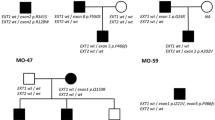Abstract
EXT1/EXT2-CDG (Multiple cartilagineous exostoses, hereditary multiple osteochondroma (MO); OMIM 133700/133701) are common defects of O-xylosylglycan glycosylation. The diagnostic criteria are at least two osteochondromas of the juxta-epiphyseal region of long bones with in the majority of cases a positive family history and/or mutation in one of the EXT genes. The authors report data on clinical symptoms and complications of 23 patients (from 16 families), discussing the family history, age of diagnosis, new clinical and molecular data. Fifteen mutations and large deletions, of which nine are new, were detected in the EXT1 and EXT2 gene by sequence analysis, FISH and MLPA analysis.

Similar content being viewed by others
Reference
Ahn J, Ludecke H, Lindow S et al. (1995) Cloning of the putative tumor suppressor for hereditary multiple exostoses (EXT1). Nat Genet 11:137–143
Alvarez C, Tredwell S, De Vera M et al. (2006) The genotype-phenotype correlation of hereditary multiple exostoses. Clin Genet 70:122–130
Bovée JV (2008) Multiple osteochondromas. Orphanet J Rare Dis 3:1–7
Clines G, Ashley J, Shah S et al. (1997) The structure of the human Multiple exostoses 2 Gene and characterization of homologues in mouse and Caenorhabditis elegans. Genome Res 7:359–367
Enneking W (1987) Modification of the system for functional evaluation in the surgical management of musculoskeletal tumors. In: Enneking WF (ed) Limb salvage in musculoskeletal oncology. Bristol-Myers orthopedic symposium. Churchill Livingstone, New York, pp 626–639
Galasso C, Scire G, Sanna M et al (1996) Growth hormone therapy in two patients with HME. Clin Pediatr 12:657–661
German GB (2008) Hereditary multiple exostoses and schizophrenia. Indian J Hum Genet 14:65–66
Jennes I, Entius M, Van Hul E et al. (2008) Mutation screening of EXT1 and EXT2 by denaturing high performance liquid chromatography, direct sequencing analysis, fluorescence in situ hybridization, and a new multiplex ligation–dependent probe amplification probe set in patients with multiple osteochondromas. J Mol Diagn 10:85–92
Jennes I, Pedrini E, Zuntini M et al. (2009) Multiple osteochondromas: mutation database (Modb). Hum Mutat 30:1620–1627
Legeai-Mallet L, Munich A, Maroteaux P et al. (1997) Incomplete penetrance and expressivity skewing in hereditary multiple exostoses. Clin Genet 52:12–16
Martinez E, Leon S, Hawkins C (2008) Growth hormone deficiency associated with hereditary multiple exostosis –growth hormone treatment in one case. Acta Pediatr 77:218–219
Porter D, Simpson A (1999) The neoplasmic pathogenesis of solitary and multiple osteochondromas. J Pathol 188:119–125
Schmale GA, Conrad EU, Rashkind WH (1994) The natural history of hereditary multiple exostoses. J Bone Joint Surg Am 76:986–992
Schmitt A, Bores A, Baran R (1997) Subungual exostosis of fingers in hereditary multiple exostosis. 3 cases. Ann Dermatol Venereol 124:233–236
Szuhai K, Jennes I, de Jong D (2011) Tiling Resolution Array-CGH shows that somatic mosaic deletions of the EXT gene is causative in EXT gene mutation negative multiple osteochondromas patients. Hum Mutat 32:2036–2049
Taniguchi K (1995) A practical classification system for multiple cartilagineous exostosis in children. J Pediatr Orthop 15:585–591
Wuyts W, van Hul W, De Boulle K et al. (1998) Mutations in the EXT1 and EXT2 genes in hereditary multiple exostoses. Am J Hum Genet 62:346–354
Acknowledgements
This work was supported by EU project EUROGLYCANET (European Network for the advancement of research, diagnosis and treatment of a growing group of rare disorders) 512131/ 01.01-2005-31.12. 2007 and Research project R14-D/ 27.07.09-27.07. 2010, Medical University-Sofia entitled “Screening for congenital disorders of glycosylation”. The Department of Medical Genetics of Antwerp is a partner of the EuroBoNeT consortium, a European Commission granted Network of Excellence for studying the pathology and genetics of bone tumours.
Author information
Authors and Affiliations
Corresponding author
Additional information
Communicated by: Eva Morava
Competing interest: None declared.
Rights and permissions
About this article
Cite this article
Stancheva-Ivanova, M.K., Wuyts, W., van Hul, E. et al. Clinical and molecular studies of EXT1/EXT2 in Bulgaria. J Inherit Metab Dis 34, 917–921 (2011). https://doi.org/10.1007/s10545-011-9314-8
Received:
Revised:
Accepted:
Published:
Issue Date:
DOI: https://doi.org/10.1007/s10545-011-9314-8




